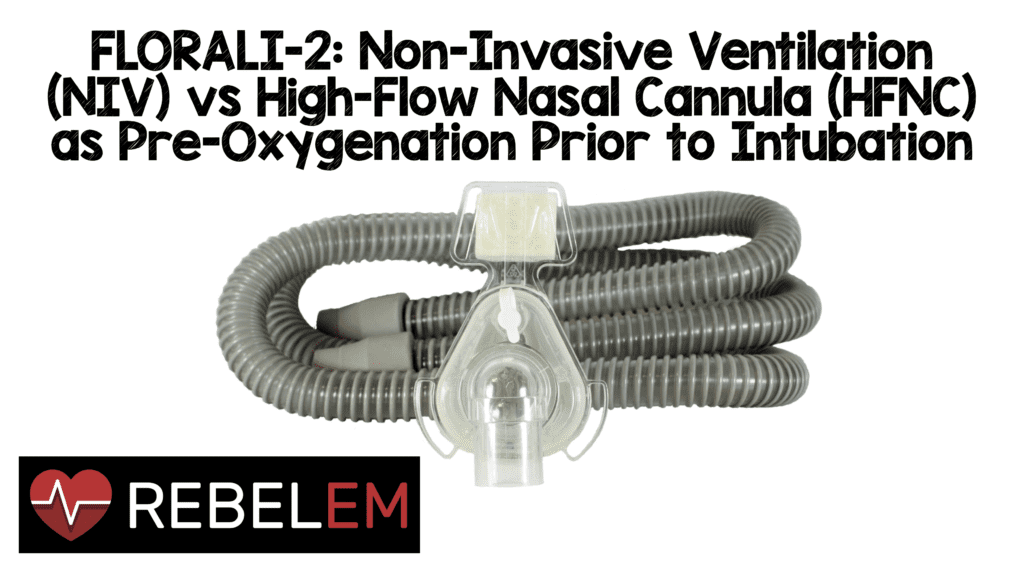
Background:Tracheal intubation is a common procedure performed on critically ill patients. In these patients, there is a high risk of life-threatening complications associated with the procedure, with severe hypoxemia being one of the more common. Development of severe hypoxemia, in turn, increases the risk of post-intubation cardiac arrest. Therefore, optimal preoxygenation is an essential part of tracheal intubation to help stave off subsequent complications.
Both NIV and HFNC can provide a higher fraction of inspired oxygen than standard oxygen therapies. HFNC can provide continuous oxygen up to 70L/min via nasal prongs with the potential advantage of remaining in place for apneic oxygenation. NIV can also provide high flow oxygen but must be removed during the apneic phase of intubation. To date there has not been a study comparing NIV vs HFNC to reduce the incidence of severe hypoxemia during intubation until now; the FLORALI-2 trial.
What They Did:
- Determine if preoxygenation with NIV is better than HFNC in reducing risk of severe hypoxemia during intubation
- Multicenter, open-label, non-blinded, parallel-group randomized clinical trial done in 28 ICUs in France
Outcomes:
- Primary: Occurrence of severe hypoxemia (i.e. Pulse oximetry <80%) for ≥5sec from beginning of RSI (end of preoxygenation) to 5min after confirmation of tracheal intubation via capnography
- Secondary:
- Value of pulse oximetry at end of preoxygenation and lowest value during intubation
- Feasibility of preoxygenation evaluated by a four-point scale (easy, quite easy, quite difficult, difficult)
- Cormack grade
- Immediate complications (arterial hypotension, sustained cardiac arrhythmia, bradycardia, cardiac arrest, death, esophageal intubation, regurgitation, gastric distension, dental injury, and new infiltrate on CXR)
- Late complications (occurrence of ventilator-associated pneumonia, worsening of SOFA score from days 1 – 7, duration of mechanical ventilation, length of stay in ICU, and mortality at day 28)
Inclusion:
- Consecutive adult patients aged >18 years, admitted to the ICU, undergoing tracheal intubation for acute hypoxemic respiratory failure:
- Respiratory rate >25 breaths per min OR
- Signs of respiratory distress OR
- PaO2/FiO2 ratio of ≤300mmHg
Exclusion:
- Cardiac arrest
- GCS <8
- Intubated prior to ICU admission
- Other contraindications to NIV (recent laryngeal, esophageal, or gastric surgery and substantial facial fractures)
- Pulse oximetry not available
- Pregnancy or breastfeeding
- Refusal to participate
Procedures:
- Preoxygenation done in a semi-recumbent position at 30 degrees for 3 – 5 minutes
- NIV group = preoxygenation delivered via a face mask connected to an ICU ventilator with pressure support ventilation to obtain an expired TV between 6mL/kg and 8mL/kg of predicted bodyweight with a PEEP of 5cmH20 and FiO2 of 1.0
- NIV provide oxygenation and ventilation during preoxygenation and between induction and laryngoscopy, but neither oxygenation nor ventilation during laryngoscopy
- NFNC group = preoxyenation delivered by applying oxygen continuously via binasal prongs with a gas flow of 60L/min through a heated humidifier and an FiO2 1.0
- Jaw thrust was performed to maintain patent upper airway
- HFNC continued during laryngoscopy until endotracheal tube placed into trachea
- HFNC therefore provided oxygenation but little ventilation during preoxygenation between induction and laryngoscopy, and also during laryngoscopy
Results:
- 322 patients enrolled
- 313 patients in the intention-to-treat analysis
- Severe Hypoxemia:
- NIV preoxygenation: 23%
- HFNC preoxygenation: 27%
- 95% CI -13.7 to 5.5
- P = 0.39
- Severe Hypoxemia:
- 242 patients with moderate to severe hypoxemia (PaO2/FiO2 ≤200mmHg)
- Severe Hypoxemia:
- NIV preoxygenation: 24%
- HFNC preoxygenation: 35%
- aOR 0.56
- 95% CI 0.32 – 0.99
- P = 0.459
- Severe Hypoxemia:
- No difference in serious immediate or late adverse events between groups
- Most common immediate complication was arterial pressure <90mmHg in ≈50% of intubations
Strengths:
- Multicenter, randomized controlled trial comparing NIV vs HFNC as preoxygenation for hypoxemic respiratory failure
- 1ststudy to compare effects of HFNC to NIV for pre-oxygenation
- Consecutive patients from 28 ICUs in France randomized
- Blinded review board checked data and decided which patients could be included in the intention-to-treat analysis
- An adjudication committee, who was unaware of study groups, reviewed all the data on pulse oximetry that were recorded and stored to analyze the events occurring during intubation
- Used the same make of pulse oximetry monitor and single-use digital sensors at all participating centers to ensure pulse oximetry was monitored equivalently
- Baseline characteristics of patients did not significantly differ between two groups with the exception of:
- More shock in HFNC group vs NIV group (25% vs 17%)
- Less PaO2/FiO2 ≤200 in HFNC group vs NIV group (73% vs 82%)
- Complete follow up at 28 days
- Randomization properly done with computer-generated blocks
Limitations:
- Physicians could not be blinded to individual patient assignments, but the coordinating center and all the investigators remained unaware of the outcomes of each study group until data were locked
- HFNC group had jaw thrust maneuver performed to ensure a patent airway and it is not clear if the NIV also got this maneuver
- Statistical analysis assumed there would be a 15% difference in severe hypoxemia between NIV and HFNC which is a big number. A more realistic difference may have been 5 – 10%
- Some episodes of severe hypoxemia may have been missed which could underestimate severe hypoxemia events
- Unfair comparisons of pre-oxygenation in patients with lung shunt physiology
- Large exclusion of patients that were intubated in ICU not included in this study making it difficult to draw conclusions on patients without hypoxemia, urgent intubation, cardiac arrest, or in a coma
- Primary outcome was a monitor-oriented outcome and not a patient-oriented outcome such as mortality
- Non-blinded study as treatment allocation could not be concealed which could bias results
Discussion:
- Difficult to draw conclusions about ED patients as 1697 patients excluded from this study as they were intubated prior to ICU admission
- Intubation medications included:
- Etomidate 0.2 – 0.3mg/kg or Ketamine 1.5 – 3.0mg/kg
- Rocuronium 0.6 – 1.0mg/kg or Succinylcholine 1.0mg/kg
- The dosing for rocuronium should be 1.2mg/kg and for succinylcholine should be 1.5mg/kg
- Pulse oximetry values, duration of laryngoscopy, and procedure of intubation did not differ between two groups
Author Conclusion:“In patients with acute hypoxaemic respiratory failure, preoxygenation with non-invasive ventilation or high-flow oxygen therapy did not change the risk of severe hypoxaemia. Future research should explore the effect of preoxygenation method in patients with moderate-to-severe hypoxaemia at baseline.”
Clinical Take Home Point: It’s hard to know what to take away from this study, as the comparisons were far from fair or even optimal. As a matter of fact, we are comparing apples to oranges. In a population of patients with severe shunt physiology we are comparing NIV (increased alveolar recruitment through higher levels of PEEP and no nasal/apneic oxygenation) to HFNC (a lower magnitude of alveolar recruitment with lower levels of PEEP + nasal/apneic oxygenation) during laryngoscopy. Essentially, less than optimal pre-oxygenation (NIV alone) with even worse pre-oxygenation (HFNC alone).
In patients with shunt physiology we must optimize pre-oxygenation by recruiting atelectatic alveoli with the best tools we have available:
- Increasing PEEP via BVM + PEEP valve with flush rate oxygen AND
- Nasal/Apneic oxygenation
References:
- Frat JP et al. Non-Invasive Ventilation Versus High-Flow Nasal Cannula Oxygen Therapy with Apnoeic Oxygenation for Preoxygenation Before Intubation of Patients with Acute Hypoxaemic Respiratory Failure: A Randomised, Multicentre, Open-Label Trial. Lancet Respir Med 2019. PMID: 30898520
Post Peer Reviewed By: Anand Swaminathan, MD (Twitter: @EMSwami)



